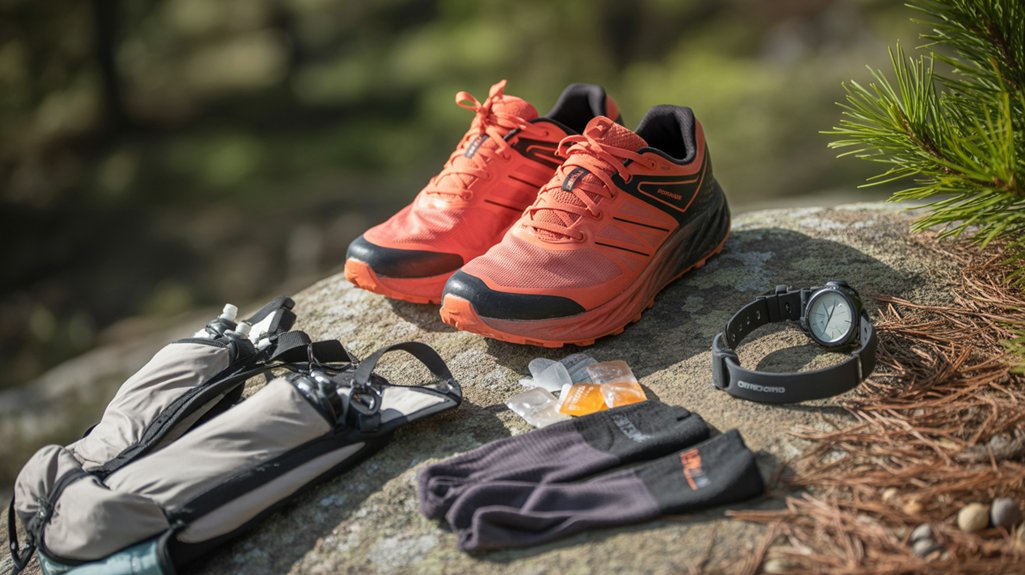You’ve probably heard trail running offers incredible benefits, but stepping off the pavement can feel intimidating when you’re unsure what gear you’ll need or how to handle rocky descents safely. The right preparation makes all the difference between a frustrating stumble through the woods and an exhilarating adventure that’ll have you planning your next trail expedition. What most beginners don’t realize is that mastering just a few fundamental principles transforms everything about your experience.
Essential Gear and Footwear for Trail Running

Trail running demands specialized gear that differs significantly from road running equipment. You’ll need trail-specific shoes with aggressive tread patterns, reinforced toe boxes, and rock plates for protection against sharp objects. Choose shoes that fit snugly but allow toe movement during descents.
Moisture-wicking clothing prevents chafing and regulates temperature. Layer strategically since trail conditions change rapidly. A lightweight, breathable base layer works best.
Essential accessories include a hydration system—either handheld bottles or a hydration pack. Carry a lightweight headlamp for early morning or evening runs. Pack energy gels or snacks for longer distances.
Don’t forget safety items: a whistle, basic first aid supplies, and your phone. Consider GPS watches for navigation and tracking progress on unfamiliar trails.
Understanding Trail Types and Terrain

Before you hit the trails, understanding different terrain types will help you choose appropriate routes and prepare mentally for what lies ahead.
Single-track trails offer narrow paths through forests, requiring focus and agility. Fire roads provide wider, less technical surfaces perfect for building endurance. Rocky terrain demands careful foot placement and stronger ankles, while rooty sections test your balance and quick reflexes.
Steep climbs will challenge your cardiovascular system and require shorter, more frequent steps. Downhill sections need controlled speed and confidence in your footing. Muddy conditions call for traction-focused footwear and acceptance that you’ll get dirty.
Start with well-maintained, less technical trails before progressing to challenging terrain. Research trail difficulty ratings and recent conditions online before heading out.
Proper Running Form and Technique on Trails

While road running emphasizes forward momentum and consistent rhythm, trail running demands adaptability and constant micro-adjustments to your form.
You’ll need to shorten your stride and increase your cadence to maintain better balance on uneven terrain. Keep your arms wider for stability and your eyes focused 10-15 feet ahead to anticipate obstacles.
When ascending, lean slightly forward and pump your arms more vigorously. Take shorter, quicker steps to maintain momentum.
For descents, lean back slightly, extend your arms for balance, and land on your forefoot with controlled steps.
Practice lifting your feet higher than usual to clear roots and rocks. Relax your shoulders and stay light on your feet.
Most importantly, you’ll develop your own rhythm through experience.
Safety Considerations and Risk Management

The wilderness presents unique hazards that don’t exist on city streets or gym treadmills. You’ll encounter uneven terrain, loose rocks, roots, and wildlife.
Always tell someone your planned route and expected return time. Carry essential safety gear: first aid kit, whistle, headlamp, and emergency shelter. Check weather conditions before heading out and turn back if storms approach.
Stay alert for trail markers and don’t rely solely on GPS devices that can fail. If you’re lost, stop moving and use your whistle to signal for help.
Avoid running alone when possible, especially on remote trails. Know your limits and don’t push beyond your abilities when you’re far from help. Start with well-marked, popular trails before attempting challenging wilderness routes.
Trail Etiquette and Environmental Responsibility

As you venture onto shared trails, you become part of a community that values both the natural environment and fellow outdoor enthusiasts.
Follow the “Leave No Trace” principles: pack out all trash, stay on designated trails, and avoid disturbing wildlife. When encountering other trail users, practice proper right-of-way etiquette. Hikers have the right-of-way over runners, and everyone yields to horses. Step aside with a friendly greeting when passing.
Respect trail closures and seasonal restrictions designed to protect sensitive ecosystems. Don’t pick plants or disturb natural features.
Keep noise levels down to preserve the peaceful atmosphere others seek. If you’re running with music, use only one earbud to stay aware of your surroundings and other trail users approaching.
Building Your First Training Plan

Now that you understand proper trail behavior, you’re ready to create a structured approach to your running development. Start with three runs per week, alternating between easy trail runs and one slightly longer session.
Begin conservatively—aim for 20-30 minutes initially, focusing on time rather than distance. Follow the 10% rule: increase your weekly mileage by no more than 10% each week. This prevents overuse injuries common among beginners.
Include one rest day between runs during your first month. Your weekly structure should include: one short easy run, one moderate-length run, and one longer exploration run.
Listen to your body—soreness is normal, but sharp pain isn’t. Schedule a complete rest week every fourth week to allow proper recovery and adaptation.
Conclusion
You’re now equipped with the fundamentals to start your trail running journey safely and confidently. Remember to invest in proper gear, respect the environment, and listen to your body as you build endurance. Don’t rush into challenging terrain—start with easier trails and gradually progress. Most importantly, you’ll discover that trail running isn’t just about fitness; it’s about connecting with nature and finding peace on scenic paths.


